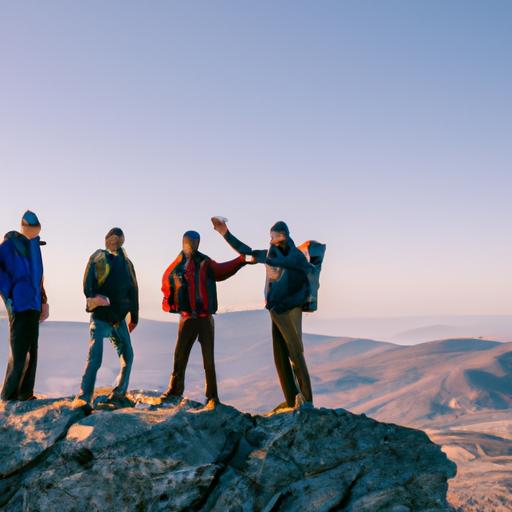What Travels Through a Food Chain: Exploring the Intricacies of Energy and Nutrient Flow

Introduction
Do you ever wonder how the delicate balance of nature is maintained? How energy and nutrients seamlessly pass through various organisms, sustaining life in ecosystems? The answer lies within the fascinating concept of a food chain. In this article, we will delve into the intricacies of what travels through a food chain, unraveling the mysteries of energy and nutrient flow.
Understanding the Food Chain
To comprehend what travels through a food chain, we must first grasp its fundamental definition. A food chain represents a linear sequence of organisms, where each member serves as a source of food for the next in line. It outlines the interdependence of life forms, showcasing the transfer of energy and nutrients from one organism to another.
The Importance of Understanding the Journey
Embarking on this exploration holds immense significance. By comprehending what travels through a food chain, we gain insight into the delicate balance that sustains our ecosystems. It allows us to understand the interconnections between species, the impact of disruptions, and the consequences for the overall ecosystem health.
Overview of the Article
Throughout this article, we will embark on an exciting journey through the realms of the food chain. We will uncover the key elements that make up a food chain, explore the flow of energy and the vital role of nutrient cycling. Together, we will examine examples from marine and terrestrial ecosystems, shedding light on the incredible dynamics that occur within these intricate webs of life.
Are you ready to dive into the captivating world of the food chain? Let’s embark on this enlightening journey together, uncovering the secrets of energy and nutrient flow that shape our planet’s ecosystems.
Key Elements of a Food Chain
A. Producers and Their Vital Role
At the very foundation of every food chain, we find the unsung heroes known as producers. These remarkable organisms, mainly plants and some types of bacteria, have the incredible ability to convert sunlight into energy through the process of photosynthesis. They serve as the primary source of nourishment in the food chain, providing sustenance for all other organisms.
B. Primary Consumers: The First Link
Moving up the food chain, we encounter the primary consumers. These herbivores directly feed on the producers, consuming plant material to fulfill their nutritional needs. From the gentle grazers on the grasslands to the leaf-munching insects in forests, primary consumers play a vital role in channeling energy from the producers to higher trophic levels.
C. Secondary Consumers: The Predatory Predators
As the food chain progresses, secondary consumers come into the spotlight. These carnivores feed on primary consumers, exerting their predatory prowess to secure their sustenance. From the swift and agile cheetah preying on herbivores to the cunning snakes lurking in the undergrowth, secondary consumers play a crucial role in regulating population sizes and maintaining ecosystem balance.
D. Tertiary Consumers: The Apex Predators
At the top of the food chain reign the apex predators, known as tertiary consumers. These mighty creatures, often large carnivores, occupy the highest trophic level and feed on secondary consumers. Think of the awe-inspiring lions of the savannah or the majestic killer whales of the oceans. Tertiary consumers exert significant influence on the entire food chain, shaping the population dynamics of lower trophic levels.
Understanding the roles of producers, primary consumers, secondary consumers, and tertiary consumers allows us to grasp the intricate web of interactions within a food chain. They form the backbone of energy transfer, ensuring the flow of nutrients and sustaining life in ecosystems. Now that we have explored the key elements, let’s dive deeper into the fascinating world of energy flow within a food chain.
Energy Flow in a Food Chain
Understanding the Transfer of Energy
Now that we have a grasp of what a food chain entails, let’s explore how energy flows through this intricate web of life. Energy is transferred from one organism to another as they consume and are consumed. This transfer occurs as chemical energy stored in food is converted into usable energy by organisms.
The Sun’s Vital Role
While energy can neither be created nor destroyed, it must originate from a source. In the case of a food chain, the primary source of energy is the sun. Through the process of photosynthesis, plants and other autotrophs harness the sun’s energy to convert carbon dioxide and water into glucose, a form of chemical energy. This process not only sustains plants themselves but also provides the foundation for energy flow within the food chain.
Unveiling the Energy Pyramid
To better understand the dynamics of energy flow, we rely on a powerful visualization tool—the energy pyramid. This pyramid depicts the distribution of energy among different trophic levels within a food chain. At the base, we find the producers, such as plants, which capture the maximum amount of energy from the sun. As we move up the pyramid, energy availability decreases, as some energy is lost as heat or used for metabolic processes.
Significance of the Energy Pyramid
The energy pyramid is a testament to the efficiency and limitations of energy transfer within a food chain. It highlights the fact that energy diminishes as it moves up the trophic levels. Each level can sustain a limited number of organisms due to this energy loss. As a result, top predators, occupying the highest trophic level, have the smallest population size, as they rely on the energy accumulated from all the lower levels.
By understanding the flow of energy within a food chain and the role of the sun as its ultimate source, we gain a deeper appreciation for the delicate balance that allows life to thrive. The energy pyramid serves as a visual representation of the efficiency and constraints of energy transfer, reminding us of the interconnectedness and interdependence of all organisms in an ecosystem.
Nutrient Cycling in a Food Chain
A. Introduction to Nutrient Cycling
In the intricate dance of the food chain, there is another vital player that ensures the sustainability of ecosystems: nutrient cycling. Nutrient cycling refers to the process by which essential elements, such as carbon, nitrogen, and phosphorus, are recycled and reused within an ecosystem. It involves the continuous movement of nutrients between the biotic and abiotic components of the environment.
B. Decomposers: Nature’s Recycling Heroes
At the heart of nutrient cycling are the unsung heroes of the natural world: decomposers. Decomposers, including bacteria, fungi, and detritivores, play a crucial role in breaking down organic matter and returning nutrients to the soil or water. Through their remarkable ability to break down complex molecules, decomposers release essential nutrients that can be absorbed by plants and utilized by other organisms in the food chain.
C. The Importance of Nutrient Recycling for Ecosystem Sustainability
The significance of nutrient recycling cannot be overstated. It ensures that vital elements essential for life are continuously available in the ecosystem, promoting sustainability and balance. Without proper nutrient cycling, ecosystems would suffer from nutrient depletion, hindering the growth and survival of organisms at various trophic levels. By recycling nutrients, ecosystems can maintain their productivity, supporting a diverse array of life forms and contributing to the overall health of our planet.
As we unravel the mechanisms of nutrient cycling within the food chain, we gain a deeper understanding of the intricate web of connections that sustain life. The role of decomposers as nature’s recycling heroes highlights the importance of their often-overlooked contribution. Let us now embark on a journey to explore concrete examples of what travels through a food chain, showcasing the beauty and complexity of nutrient cycling in action.
Examples of What Travels Through a Food Chain
As we continue our journey into the world of food chains, let’s explore some captivating examples that highlight the fascinating dynamics of energy and nutrient flow within different ecosystems.
Example 1: Marine Food Chain
The vast expanse of the ocean is teeming with life, and its food chain showcases a captivating interplay between various organisms. Let’s unravel the marine food chain and discover what travels through its intricate web.
-
Producers (phytoplankton): These microscopic organisms, such as algae and cyanobacteria, harness the power of sunlight through photosynthesis. They form the foundation of the marine food chain by converting solar energy into organic matter.
-
Primary consumers (zooplankton): Zooplankton, including tiny crustaceans and larval forms of various marine animals, feed on the phytoplankton. They serve as the primary consumers in the chain, transforming the energy stored in plants into their own growth and survival.
-
Secondary consumers (fish): Moving up the marine food chain, we encounter fish that rely on zooplankton as their primary source of sustenance. These fish, such as herring or anchovies, consume vast quantities of zooplankton to fuel their energy needs.
-
Tertiary consumers (sharks): At the top of the marine food chain, we find the apex predators like sharks. These majestic creatures feast on smaller fish, establishing their role as tertiary consumers. They play a crucial part in regulating the population of lower-level organisms, ensuring a balanced ecosystem.
Example 2: Terrestrial Food Chain
On land, the food chain exhibits its own unique intricacies. Let’s explore an example from the terrestrial realm and uncover what travels through this captivating web of life.
-
Producers (plants): Plants, ranging from towering trees to delicate wildflowers, form the foundation of the terrestrial food chain. Through photosynthesis, they convert sunlight into energy-rich compounds, serving as the primary producers.
-
Primary consumers (herbivores): Herbivores, such as deer, rabbits, or giraffes, graze on the abundant plant life. They consume vegetation to meet their energy needs, acting as the primary consumers in the terrestrial food chain.
-
Secondary consumers (carnivores): Carnivores enter the stage as the secondary consumers, preying on herbivores. These predators, like lions, wolves, or hawks, derive their energy by consuming other animals.
-
Tertiary consumers (top predators): At the pinnacle of the terrestrial food chain, we find the top predators. These apex predators, like tigers or eagles, serve as the ultimate consumers, feeding on other carnivores. Their presence maintains the delicate balance within the ecosystem.
Through these examples, we witness the captivating intricacies of what travels through a food chain. Whether in the vast ocean or on land, the flow of energy and nutrients weaves together the diverse species, creating a harmonious symphony of life.
Conclusion
In conclusion, understanding what travels through a food chain is essential for comprehending the intricate dynamics that sustain our ecosystems. By recognizing the interdependence of organisms and the flow of energy and nutrients, we gain a deeper appreciation for the delicate balance of nature.
Through this exploration, we have uncovered the key elements of a food chain, including producers, primary consumers, secondary consumers, and tertiary consumers. We have also discussed the crucial roles that energy flow and nutrient cycling play in maintaining ecosystem sustainability.
By examining examples from marine and terrestrial ecosystems, we have witnessed the fascinating journey of energy and nutrients through various organisms. From phytoplankton to sharks in the marine food chain, and from plants to top predators in the terrestrial food chain, we have witnessed the intricate connections that ensure the survival of species.
This knowledge holds immense value in ecological awareness and conservation efforts. Understanding what travels through a food chain allows us to recognize the potential consequences of disruptions and the importance of preserving biodiversity. It empowers us to make informed decisions to protect and restore ecosystems, ensuring a harmonious coexistence with nature.
As we conclude this enlightening journey, let us embrace our responsibility as stewards of the Earth. Let us strive to deepen our understanding of the food chain and its intricate mechanisms, working together to safeguard the delicate balance of life that sustains us all.
So, the next time you ponder the wonders of the natural world, remember the intricate journey of energy and nutrients that travel through a food chain. It is a testament to the remarkable interconnectedness of life, reminding us of the awe-inspiring beauty and resilience of our planet.
Conclusion: So above is the What Travels Through a Food Chain: Exploring the Intricacies of Energy and Nutrient Flow article. Hopefully with this article you can help you in life, always follow and read our good articles on the website: travel.lakeviewinnmn.com




